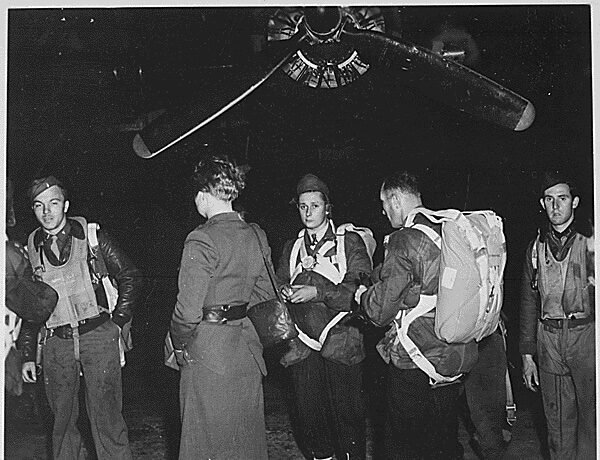
As the United States stood on the brink of World War II, President Franklin D. Roosevelt recognized the urgent need for innovative military strategies to effectively confront the impending global conflict. Observing the unfolding events in Europe, he realized that defeating the Axis powers would require pioneering approaches to warfare. Roosevelt turned to William J. Donovan, a trusted advisor and former informal emissary, to develop a visionary plan for a global intelligence collection agency.
Donovan, a WWI veteran, drafted the “Establishment of Service of Strategic Information,” a detailed document outlining a groundbreaking framework for a centralized intelligence organization to coordinate the entire government and gather essential data for strategic planning. In his plan, Donovan emphasized that “strategy, without reliable information, is helpless. Likewise, information is useless unless intelligently directed toward strategic purposes.”
Impressed by Donovan’s insight, President Roosevelt established the Coordinator of Information (COI)—the nation’s first national intelligence agency. This marked a pivotal moment in US history, as Roosevelt’s foresight and Donovan’s strategic acumen laid the groundwork for creating an entity that would revolutionize how the United States managed conflict during peacetime and war. Operating under the President’s Executive Office, the COI collected and analyzed information crucial to national security.
Breaking Boundaries: The Transition from COI to OSS
A year later, Donovan presented a transformative proposal to restructure the COI into an organization that included covert and clandestine operations in addition to intelligence gathering. He envisioned a new hybrid organization that would shift warfighting from traditional military tactics to unconventional approaches using sabotage, espionage, guerrilla warfare, and psychological operations. Believing in Donovan’s strategic expertise, President Roosevelt approved the proposal, thus creating the Office of Strategic Services (OSS) on June 13th, 1942. The OSS would operate under the Joint Chiefs of Staff, a committee of senior military leaders formed during World War II to advise the President and coordinate military efforts.
Under Donovan’s leadership, the OSS bridged the realms of diplomacy, intelligence, and the military. He recruited technology, economics, psychology, and finance experts to provide specialized knowledge to military operations. Donovan firmly believed in a two-pronged strategy: physically attacking the enemy’s military forces and targeting their morale and spirit. The OSS quickly became a hotbed of innovation, employing diverse specialists, including intelligence analysts, linguists, and field operatives.
Inspired by the British Special Operations Executive (SOE), Donovan developed a unique training methodology. He prioritized specialized training for recruits to operate behind enemy lines and carry out sabotage missions. They underwent rigorous training in organizing and supporting guerrilla and partisan resistance forces. At the core of the OSS were the Strategic Services Operations (SSO), consisting of six units, each with its specialized areas of expertise and responsibilities. Notably, units like the Special Operations (SO) and the Operational Group (OG) eventually led to the formation of the twelve-person Operational Detachment-Alpha, commonly known today as the Green Berets.
From the Shadows to the Waterfront
During Operation Torch, the Allied invasion of French North Africa, the OSS demonstrated its strategic prowess. OSS members infiltrated Vichy French Northwest African territory, gathering vital information about enemy forces and defenses, directly influencing the invasion’s planning. The OSS also established and maintained robust contacts with local resistance groups and the Free French forces, significantly undermining the Axis stronghold in the region. Further, through unconventional warfare, the OSS successfully disrupted enemy activities and diverted resources, hindering Axis forces from mounting an effective defense against the main invasion.
However, Operation Torch also exposed some of the OSS’s shortcomings. They underestimated the resistance from the Vichy French forces, resulting in two days of intense, unexpected fighting. Additionally, they overestimated the disruptive potential of the French resistance against the Axis forces, leading to strategic missteps. Some intelligence provided by the OSS also proved to be incorrect or unreliable, causing further complications in the operation’s planning and execution. Despite these setbacks, the experiences from Operation Torch provided invaluable lessons for future operations, including Operation Jedburgh.
During Operation Jedburgh, a covert operation involving clandestine activities, the OSS provided personnel, equipment, and training to three-man teams. These teams were airdropped into occupied Europe, primarily focusing on France, to disrupt German military operations, gather intelligence, and support the larger Allied campaign. Consisting of a commander, an executive officer, and a radio operator, they played a pivotal role in leading local resistance movements against the Germans and carrying out acts of sabotage and guerrilla warfare. Notably, one team member always possessed fluency in the local language, ensuring effective communication and coordination with regional allies.
In addition to providing personnel and training, the OSS handled logistics, the deployment of the teams, and the ongoing supply drops. Much like in Operation Torch, the effectiveness of the teams in Operation Jedburgh varied. They successfully disrupted German communications and logistics in some regions, significantly undermining the German response to the Allied invasion. However, German countermeasures, geography, and local conditions made their efforts less effective in other areas. Nevertheless, Operation Jedburgh showcased the potential of unconventional warfare and marked a successful collaboration between the OSS, the SOE, and the Free French.
The adaptability of OSS allowed them to operate in vastly different terrains. During Operation Greenup, OSS agents undertook a perilous mission to infiltrate enemy lines in the dangerous terrain of the Austrian Alps. Operatives navigated treacherous mountain passes and evaded enemy detection to gather intelligence on a secret Nazi Alpine fortress. This daring operation showcased the OSS agents’ courage and resilience as they operated deep within enemy territory, collecting critical information to support the Allies. Similarly, in the dense jungles of Burma, OSS’s Detachment 101 waged a relentless guerrilla war against the Japanese occupation. Working closely with local resistance groups, they disrupted enemy supply lines and executed devastating hit-and-run attacks. Simultaneously, they gathered vital intelligence that furthered the Allied cause.
Inspiring Psyops and FSSF in World War II
Beyond the operational successes, the OSS was an inspiration and model for various special units during World War II. In March 1942, General George Marshall, the US Army Chief of Staff, approved Project Plough, an operation to drop commandos by parachute into Nazi-occupied Norway to carry out covert operations. Subsequently, on July 9th, 1942, the First Special Serves Forces (FSSF) was officially established, bringing together units from the US and Canada. Their training and operations were similar to those of the OSS, employing similar skills and tactics. After careful evaluation, military leaders determined that the anticipated benefits of the mission were outweighed by the potential dangers, leading to its cancellation. Instead, the FSSF deployed to the Aleutian Islands campaign, fighting against the Japanese forces occupying the islands.
Following their involvement in the Aleutian Islands campaign, the FSSF deployed to Italy, actively participating in several military campaigns crucial to the Allies’ efforts. Their courage and combat effectiveness earned them the nickname ‘The Devil’s Brigade.’ The FSSF made significant contributions to the liberation of Southern France, showcasing their ability to undertake complex operations and support the overall Allied efforts.
General Dwight D. Eisenhower recognized the pivotal role of psychological warfare in the European campaign and appointed Brigadier General Robert Alexis McClure to lead the Information and Censorship Section (INC) within the Allied Forces headquarters as the war reached a critical phase. The INC’s role aligned more with the analytical and strategic planning branches of the OSS, which compiled and processed intelligence to support strategic decision-making. McClure used military personnel and civilians from the OSS and the British Political Warfare Executive to employ propaganda, misinformation, and other psychological techniques to manipulate enemy combatants’ and civilian populations’ perceptions and attitudes. In 1944, Eisenhower tasked McClure with establishing the Psychological Warfare Division of the Supreme Headquarters, Allied Expeditionary Force (PWD/SHAEF), to meet the evolving needs of theater commands in the dynamic and volatile landscape of the war.
The Disbandment of the OSS and FSSF in Post-War Reorganization
In January 1945, during the Battle of the Bulge and as Allied forces gained ground on the Eastern flank, Senior officials decided to disband the FSSF in Southern France. The FSSF played a commendable role across various theaters, but leaders no longer deemed their specialized services necessary as the war neared its final stages. The surrender of Nazi Germany on May 7th, 1945, marked the end of World War II in the European theater. Throughout the conflict, the OSS adapted remarkably to meet the evolving demands of theater commands. After the war, the OSS disbanded to streamline and optimize intelligence operations in the post-war era, splitting to form the Central Intelligence Agency (CIA) and the Department of State’s Bureau of Intelligence and Research.
In the subsequent years, McClure advocated for creating the Office of the Chief of Psychological Warfare (OCPW) to continue unconventional warfare as a potential European invasion by the Soviets loomed. He appointed Colonel Aaron Bank, a former OSS member, as the Operations Branch Chief of the Pentagon’s OCPW. Bank, following in the footsteps of Donovan, went on to create Special Forces. He recruited veterans from the Philippine guerrillas, the FSSF, and the OGs of the OSS. Individuals such as former Philippine guerrilla commanders Colonel Wendell Fertig and Lieutenant Colonel Russell W. Volkmann played pivotal roles in developing the doctrine of unconventional warfare, which became the cornerstone of US Special Forces.
Donovan’s OSS has left a lasting legacy in the special operations and intelligence communities. Today, entities such as Psyops, the Green Berets, and CIA operatives can all trace their roots back to the OSS. The OSS’s innovative approaches to psychological warfare, intelligence gathering, and unorthodox tactics during WWII laid the foundational framework of modern US Special Operations.
Major Nicholas Dockery is an active-duty Special Forces officer, a researcher fellow for the Modern War Institute at West Point, and a Downing scholar. He holds an MPP from the Yale Jackson School of Global Affairs graduate and is an alumnus of the United States Military Academy.
The views expressed are those of the author and do not reflect the official position of the United States Military Academy, Department of the Army, or Department of Defense.








Recent Comments